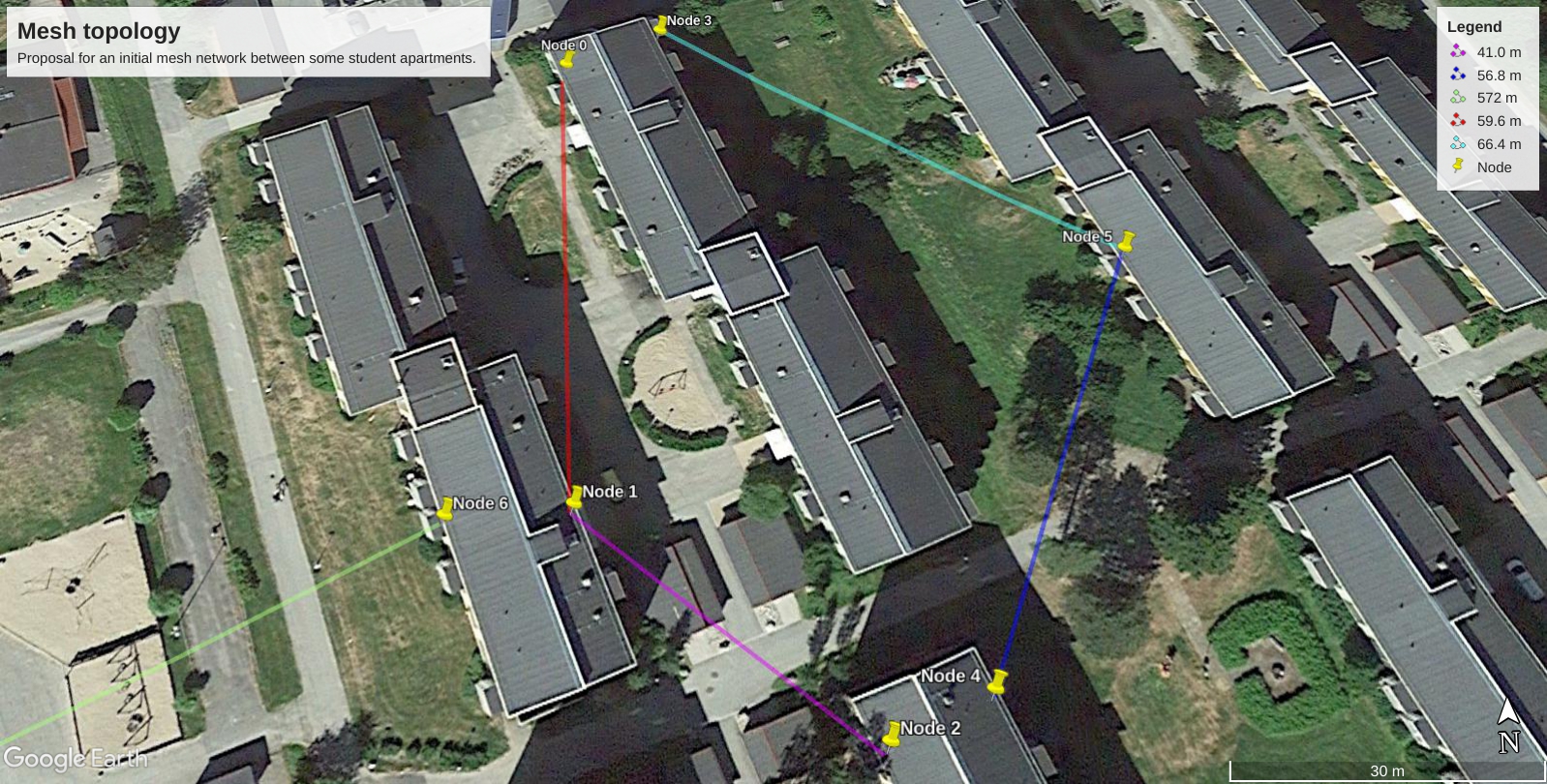
Luleå, Sweden, is actually not that far away from Hyperborea.
Note: I’m actually talking about the Cjdns mesh network, Hyperboria, not any mythical utopia.
Background
I’ve been thinking of running a mesh network since ~4 years ago when I and a classmate had a school project where we tried to make an Cjdns network that was easy to join for everyone using a user friendly captive portal.
So, now I’m at it again, and forcing some friends to participate in a IBSS + B.A.T.M.A.N Advanced + Cjdns or 802.11s + Cjdns network. I’m still unsure of the stack and looking into alternatives. The goal I had with the old school project was a distributed and encrypted mesh network for everyone. The distributed and encrypted part is even more important today for me as an European due to the Directive on Copyright in the Digital Single Market (article 11 and 13) that some crazy parties in the EU is trying to pass.
Intial mesh topology and plan
Below is an initial plan for a small mesh network between some student apartments.

The plan is to start with a test between Node 0 and Node 1, where we test
the throughput and stability of different potential stacks. The other nodes, 2
to 5, will be added one at a time, continuing with the tests (and maybe we’ll
come up with new tests). Lastly, there is a Node 6, which is a potential link
that could be aimed towards the university. With this link we could get near 1
Gbit/s (with the right hardware) to the Internet. There is also 40 Gbit/s links
to the university that could be connected (wishful thinking).
If we are able to get above 100 Mbit/s speeds and good enough latency the network could even replace the local ISP’s - creating a student ISP that all students can freely connect to as long as they have the right hardware.
Hardware and drivers
Atheros is by far the best option because of their open source drivers and
stability. The ath10k drivers sadly requires firmware blobs, but the
chipsets supports IEEE 802.11ac which would offer higher throughput than an
ath9k and ath9k_htc supported IEEE 802.11a/b/g/n chipset. And maybe the
firmware blob will be liberated in the future as the ath9k_htc firmware blobs?
Why am I so biased towards the Atheros chipsets? I’ve had experience with both
the Intel and Realtek chipsets, and there’s always a bug that gets in the
way, where Realtek is the worst offender. Intel atleast works, but I get driver
(iwlwifi) crashes when running in Ad-Hoc mode sometimes (during association).
So let’s look into some of the Atheros drivers that are interesting.
Drivers overview
Sources
- Linux Wireless (https://wireless.wiki.kernel.org/en/users/Drivers)
- WikiDevi (https://wikidevi.com/wiki/Atheros)
ath9k
- Completely FOSS, no blobs
- Both PCI/PCIe and AHB WLAN
- Driver framework: mac80211
- MAC architecture: SoftMAC
- Supported chipsets:
- AR2427 1×1 SB (no 11n)
- AR5008: AR5418+AR5133 AR5416+AR5133 AR5416+AR2133
- AR9001: AR9160 2×2 DB AR9102 2×2 SB AR9103 3×3 SB
- AR9002: AR9220 2×2 DB AR9223 2×2 SB AR9227 2×2 SB AR9280 2×2 DB AR9281 2×2 SB AR9285 1×1 SB AR9287 2×2 SB
- AR9003: AR9380 3×3 DB AR9382 2×2 DB AR9331 1×1 SB AR9340 2×2 DB
- AR9004: AR9485 1×1 SB AR9462 2×2 DB AR9565 1×1 SB AR9580 3×3 DB AR9550 3×3 DB
- Modes of operation:
- Station
- AP
- IBSS
- Monitor
- Mesh point
- WDS
- P2P GO/CLIENT
- Features:
- 802.11abg
- 802.11n
- HT20
- HT40
- AMPDU
- Short GI (Both 20 and 40 MHz)
- LDPC
- TX/RX STBC
- 802.11i
- WEP 64 / 127
- WPA1 / WPA2
- 802.11d
- 802.11h
- 802.11w/D7.0
- WPS
- WMM
- LED
- RFKILL
- BT co-existence
- AHB and PCI bus
- TDLS
- WoW
- Antenna Diversity
- Problems:
ath9k_htc
- Free driver, liberated firmware, no blobs
- Supported chipsets:
- AR9271 and AR7010 USB-PCIe bridge with AR928x wireless chips
- Supported devices:
- Driver framework: mac80211
- MAC architecture: SoftMAC
- Modes of operation and features:
- Station Mode
- Monitor Mode
- AP Mode (note: AP mode works only with up to 7 stations due to a firmware limitation)
- IBSS Mode
- Mesh Mode
- Legacy (11g) operation
- HT support
- TX/RX 11n AMPDU aggregation
- HW Encryption
- LED
- Suspend/Resume
- Problems:
- Somewhat young hardware/drivers
- AP mode limitation of 7 stations
- Experimental AP/P2P
ath10K
- Free driver but requires non-free firmware blob (https://wireless.wiki.kernel.org/en/users/drivers/ath10k/firmware)
- Driver framework: mac80211
- MAC architecture: SoftMAC
- Supported chipsets:
- QCA6164, QCA6164A, QCA6174, QCA6174A, QCA9377, QCA9880,
- QCA9882, QCA9887, QCA9890, QCA9892 and QCA9980
- Supported devices:
- Modes of operation and features:
- Station Mode
- IBSS Mode (partial)
- AP Mode
- Mesh Mode (partial)
- Monitor Mode (partial, firmware dependant)
- Packet injection (partial, firmware dependant)
- Problems:
- Firmware does not support association to the same AP from different virtual STA interfaces (driver prints “ath10k: Failed to add peer XX:XX:XX:XX:XX:XX for VDEV: X” in that case)
- Packet injection isn’t supported yet, applying ath9k regulatory domain hack patch from OpenWRT causes firmware crash (reason: regulatory hint function is never called and ath10k never sends scan channel list to the firmware which in turn causes firmware to crash on scan)
- Tx rate is reported as 6mbps due to firmware limitation (no tx rate information in tx completions); instead see /sys/kernel/debug/ieee80211/phyX/ath10k/fw_stats
- Ath10k does NOT support older QCA98xx hw1.0 chips
- Some of Compex WLE900VX fail to enumerate as PCI device, probably for an electric issue